Poland / Rzeczpospolita Polska – Let’s explore here
What’s it like in Poland?
The south of Poland is absolutely spectacular – full of hills and mountains, which it shares with Slovakia. The Carpathian mountain range, and in particular the Tatra Mountains, between Poland and Slovakia, are beautiful to behold. The highest point is Mount Rysy in the Tatra mountains, at 8,205 ft (2,501m) above sea level.
Everywhere else in Poland there are vast plains filled with agricultural land taking up the central and northern parts towards the Baltic Sea. The long coast to the north is full of sand dunes, spits and lagoons.
It’s a relatively large country; slightly bigger than Italy; which takes quite some time to travel across and through. The population is quite sizeable too (38 million in 2022), particularly in relation to some of its Baltic neighbours – and you can sense the increase in numbers everywhere you go.
There are also an enormous amount of churches – many of which appear to be fairly new – almost 90% of the population claims to be Christian.
It has an incredibly rich and varied history that has impacted all of Europe and beyond. It’s been a Kingdom since the middle ages, and along with Lithuania, it was a great power in those times, establishing Europe’s first constitution. The invasion of Poland by the Nazis sparked World War II and its Solidarity movement helped reestablish it as a country – separate from the Soviet Union – in 1989.
The people are some of the friendliest in Europe that we met! We love Poland!

A bit about the history of Poland
Early History and Formation of the Polish State
The history of Poland dates back to the 10th century, when the first Polish state was founded by the Piast dynasty. The establishment of the Kingdom of Poland is traditionally dated to 966, when Duke Mieszko I converted to Christianity, marking the country’s integration into the Christian European world. Mieszko’s successor, Bolesław the Brave, expanded Poland’s territory and made it a powerful medieval kingdom.
Medieval Poland and the Polish-Lithuanian Commonwealth
During the Middle Ages, Poland experienced periods of expansion, internal conflict, and territorial division. In 1386, the Kingdom of Poland entered into a personal union with the Grand Duchy of Lithuania, forming the Polish-Lithuanian Commonwealth. This union, which lasted until 1795, became one of the largest and most powerful countries in Europe. The Commonwealth was a unique political entity, with an elective monarchy and a system of checks and balances.
Partitions and Loss of Independence
By the late 18th century, the Polish-Lithuanian Commonwealth was weakened by internal strife and external pressures from neighbouring empires. In 1772, 1793 and 1795, Poland was partitioned by Prussia, Russia and Austria, effectively erasing the country from the map for over a century. During this period, Polish uprisings and efforts to restore independence were suppressed, but Polish nationalism continued to simmer.
Restoration of Independence and Interwar Period
After World War I, Poland regained its independence in 1918, following the collapse of the Russian, German, and Austro–Hungarian empires. The newly re-established Second Polish Republic faced significant challenges, including political instability, territorial disputes with neighbuoring countries, and economic difficulties. Poland also navigated its position in the emerging European order between the two world wars.
World War II and Occupation
In 1939, Poland was invaded by both Nazi Germany and the Soviet Union, marking the start of World War II. The country was occupied by Germany in the west and the Soviet Union in the east. The German occupation led to the deaths of millions of Poles, including the systematic extermination of the Jewish population in the Holocaust. The Polish resistance movement, including the Home Army, played a crucial role in opposing the occupiers.
Post-War Period and Communist Era
After World War II, Poland became a Soviet satellite state, with a communist government installed under Soviet influence. The country was part of the Eastern Bloc during the Cold War, and its economy was centrally planned, leading to economic stagnation and political repression. The Polish people, however, resisted communist rule, and in 1980, the Solidarity movement, led by Lech Wałęsa, emerged as a powerful force for social and political change.
Transition to Democracy and Modern Poland
In 1989, Poland transitioned to democracy with the peaceful collapse of communism, following negotiations between the communist government and the Solidarity movement. This led to the first partially free elections in 1989 and the eventual formation of a democratic government. Poland became a member of NATO in 1999 and joined the European Union in 2004. Since then, the country has seen significant political, economic, and social transformation, emerging as one of the most successful economies in central Europe. Today, Poland is a democratic republic with a growing economy, a member of major international organizations, and an active participant in European and global affairs.
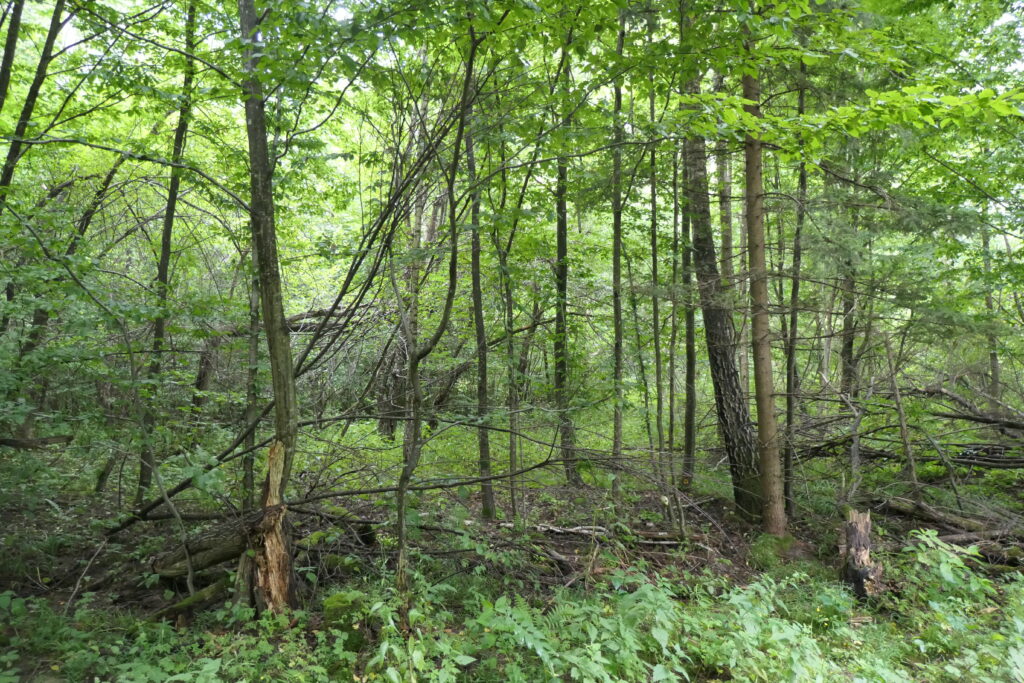
Poland road trip
We’ve created a blog for our road trip in Poland. You may find it helpful, and you may pick up some tips, or more likely mistakes not to make that we’ve made 😉 Our Polish road trip was part of a much larger European road trip.
Primeval forest
For our Polish road trip we travelled from Kaunas in Lithuania to the last remaining primeval forest in Europe based at Bialowieza, next to the border with Belarus. Its a really pretty area with lots of hiking trails, although you have to book a guide should you wish to take a long tour through the primeval forest. Whilst in the area, we were stopped multiple times at road blocks by police, who were looking for Russian Wagner group members at the time!
Eastern Poland
We stopped over at Siemiatycze, and camped at super friendly Krasne, with its lovely lake. The people on the campsite where we were went out of their way to say hi and welcome us, they were lovely!
On our way south, we visited the lovely city of Lublin, which is a really bustling town full of lovely cafés and restaurants. Sitting atop a hill, it provides some excellent views of the surrounding area.
The mountains
Driving through the amazing Polish countryside was a delight as we travelled down to the fantastic Tatra Mountains in the south of the country. The superb Lake Morskie Oko was so busy on the day arrived that we stopped over in Małe Ciche in order to get an early start in the mountains and lake the following day, and avoid the crowds.
Historic cities
Travelling north, we then stayed over in Sułkowice, south of Kraków. Sułkowice is a quick drive away from the historic city, but is a far more authentic place to stay to experience polish life. The owner was really engaging and friendly, and we ended up learning quite a lot about Polish culture. Kraków itself is simply superb, and absolute must-see when in Poland. There’s so much to see and do, and it’s really quite affordable for such a touristy place. Make sure you get there early to avoid the crowds 😉
South west Poland
From Kraków, we drove on westwards, stopping over in Kluczbork, before airing at the amazing Zamek Książ castle. And what an amazing castle it is too, so picturesque, and with some lovely trails to walk around too. Well worth the visit.
Finally we headed further west to the incredible Adršpach rocks in Czechia.
Map of our road trip through Poland

This is a map of our road trip through Poland.
Our route took us from Bialowieza Forest – Siemiatycze – Krasne – Lublin – Poronin – Małe Ciche – Lake Morskie Oko – Sułkowice – Kraków – Kluczbork – Zamek Książ
We have to say that throughout this entire journey we’ve met quite a lot of friendly people, but Poland really does top that list! The people are amazingly friendly and willing to go more that then extra mile for you – just amazing! Plus the country really is full of so many beautiful cities, towns and countryside views – just lovely 🙂
Our favourite places in Poland
These are some of the best places that we explored on our road trip through Poland. We’ve put them in alphabetical order.
Kraków
Kraków is simply stunning. We visited on a Sunday when parking is free. We stayed in accommodation outside the city, about 25 minutes away, and had no trouble at all getting to the centre and finding parking right next to the old town at midday. Although we were only there for half a day, really it’s worth spending a least a couple of days here, as there is just so much to see and do. It really is very beautiful.

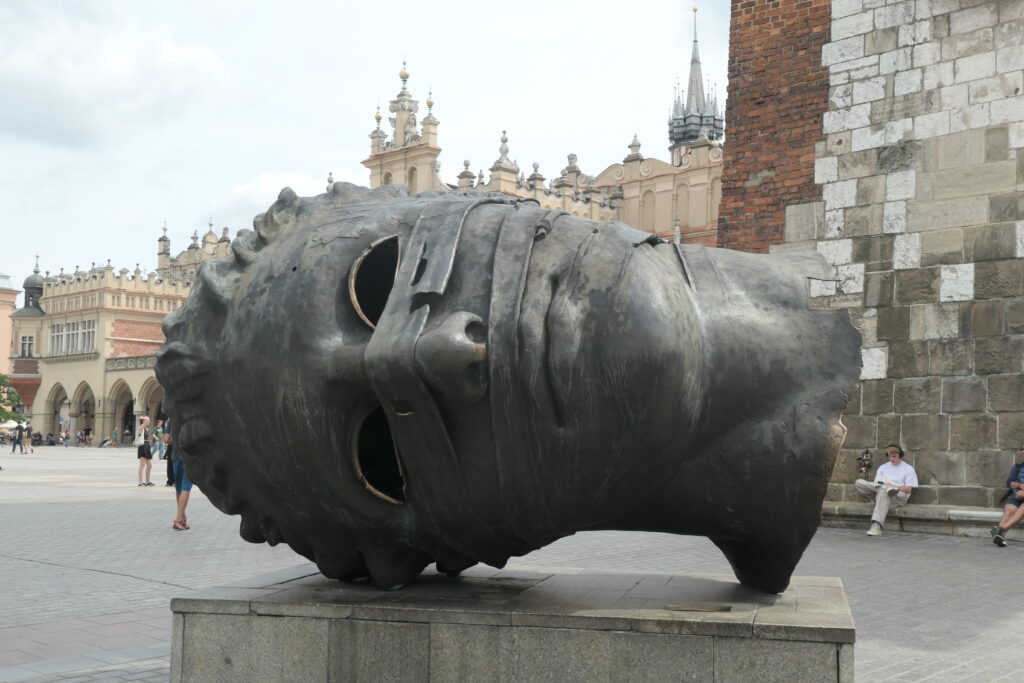
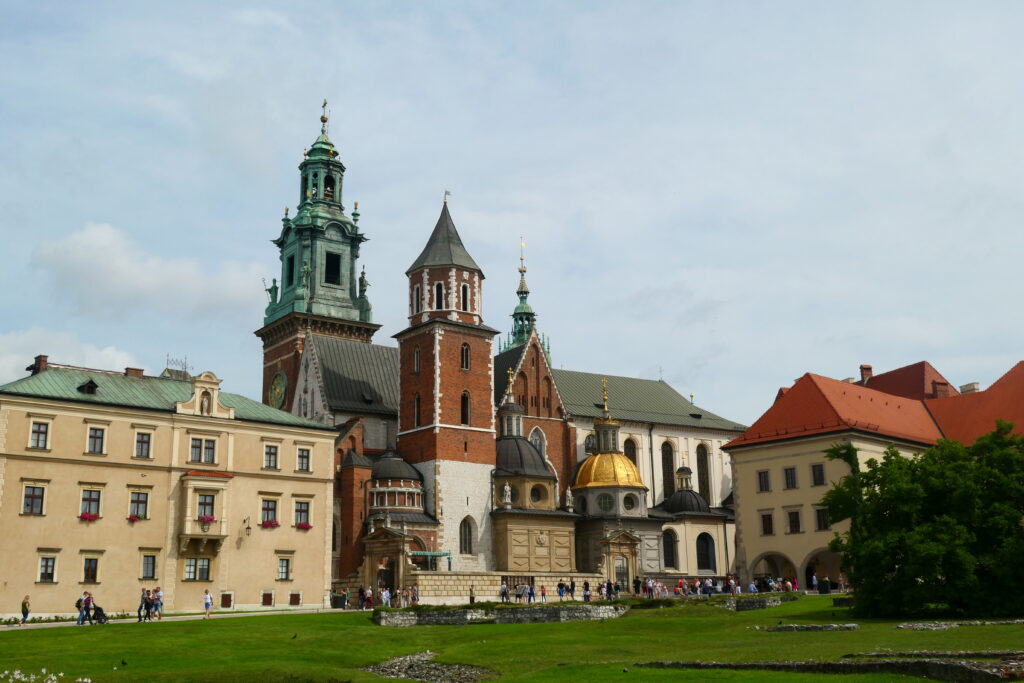
Lake Morskie Oko
Lake Morskie Oko (the eye of the sea) sits in the Tatra mountains in the south of Poland. The lake provides spectacular views, reflecting the three peaks of the Mięguszowiecki Summits.
It is one of the most popular attractions in Poland, and is thus literally overwhelmed every day of the week with visitors. When we visited the main car park was half full by 05:30, and by 07:30 cars were being turned away from all of the roads leading to the car park!
The trek itself is a fairly shallow incline over many miles, and takes approximately 2 hours to walk up and similarly back down again. If you get there early like we did, you will be greeted by glorious views; later on you will be greeted by glorious crowds! It is however well worth the trip in our view. There’s more in our blog on Poland.
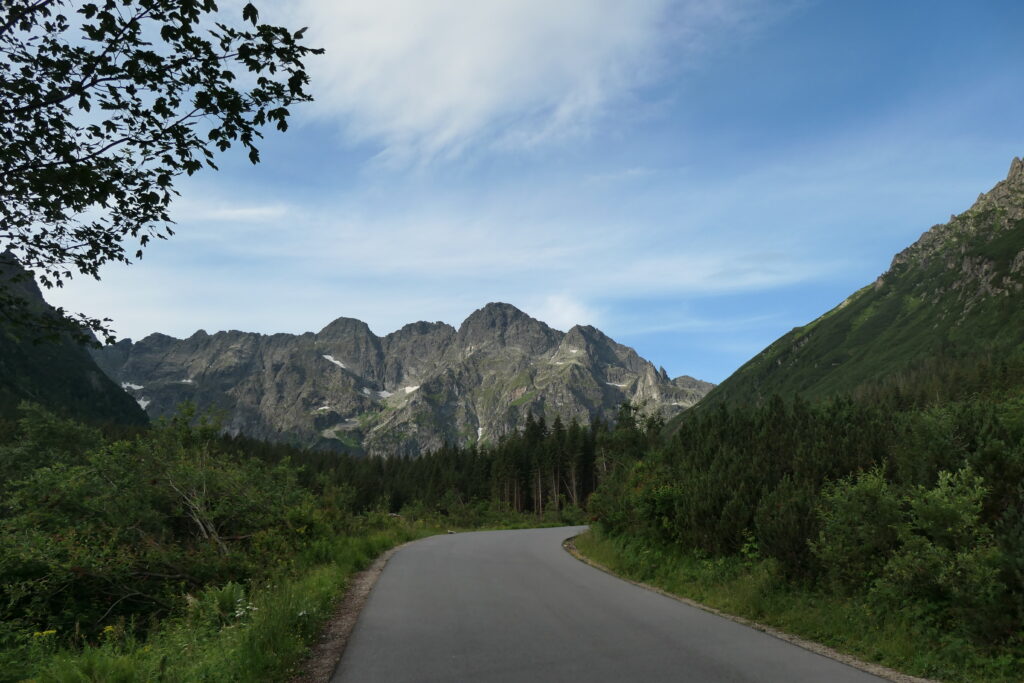
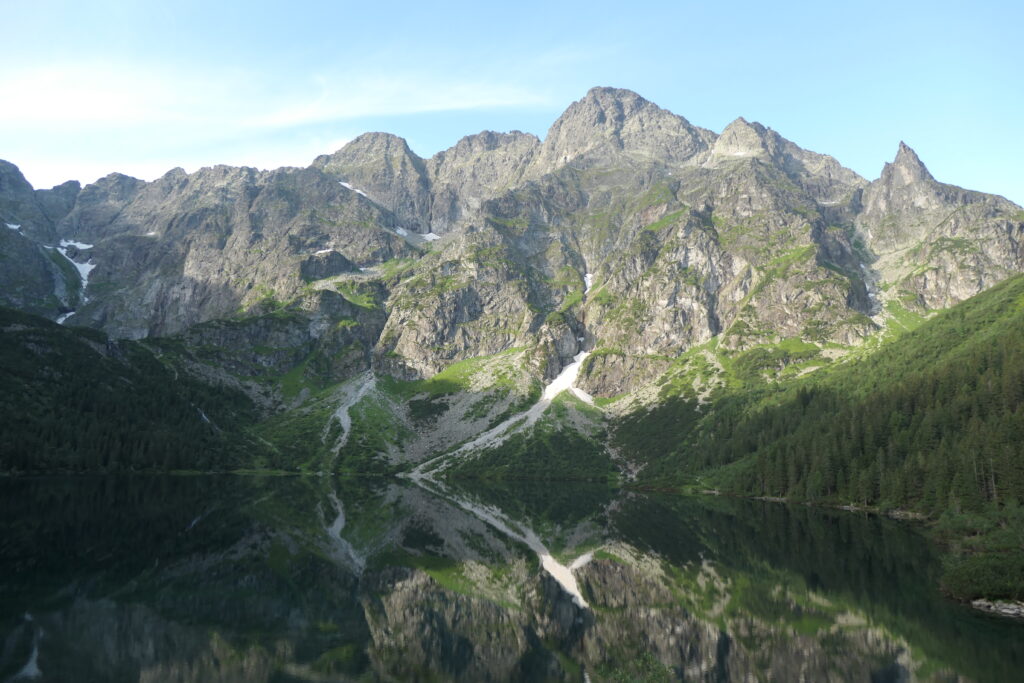

Zamek Książ
Zamek Książ castle sits within a protected landscaped park overlooking a forest filled gorge. South east of Wrocław, it’s fairly near to the Czech border, and thus the landscape around there is no longer flat but more hilly. It’s a beautiful and large castle that was built in the 13th century.

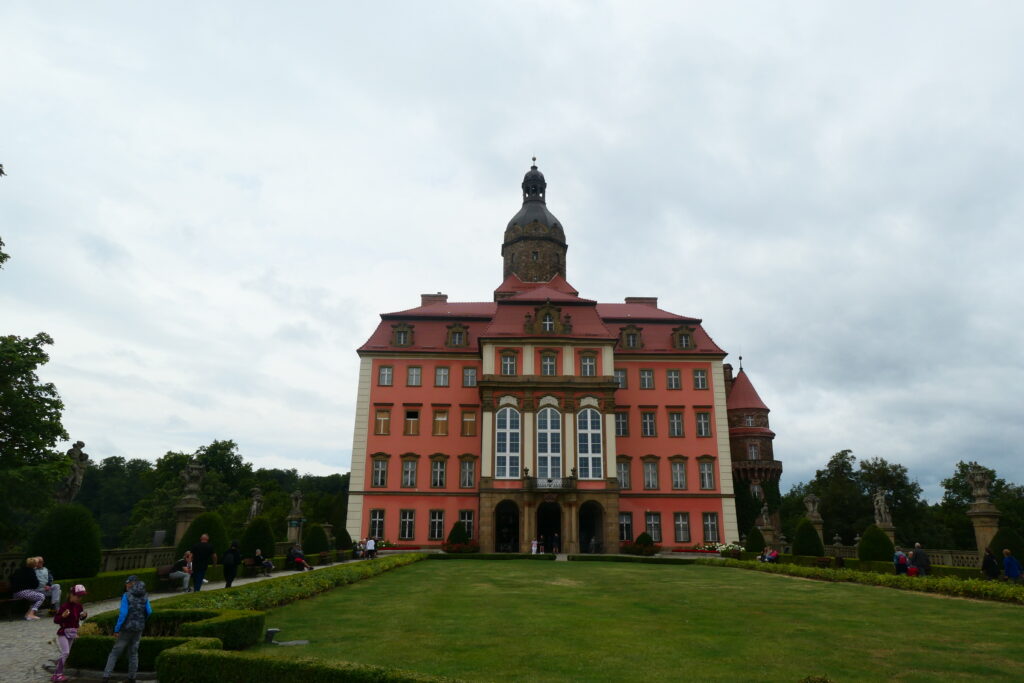
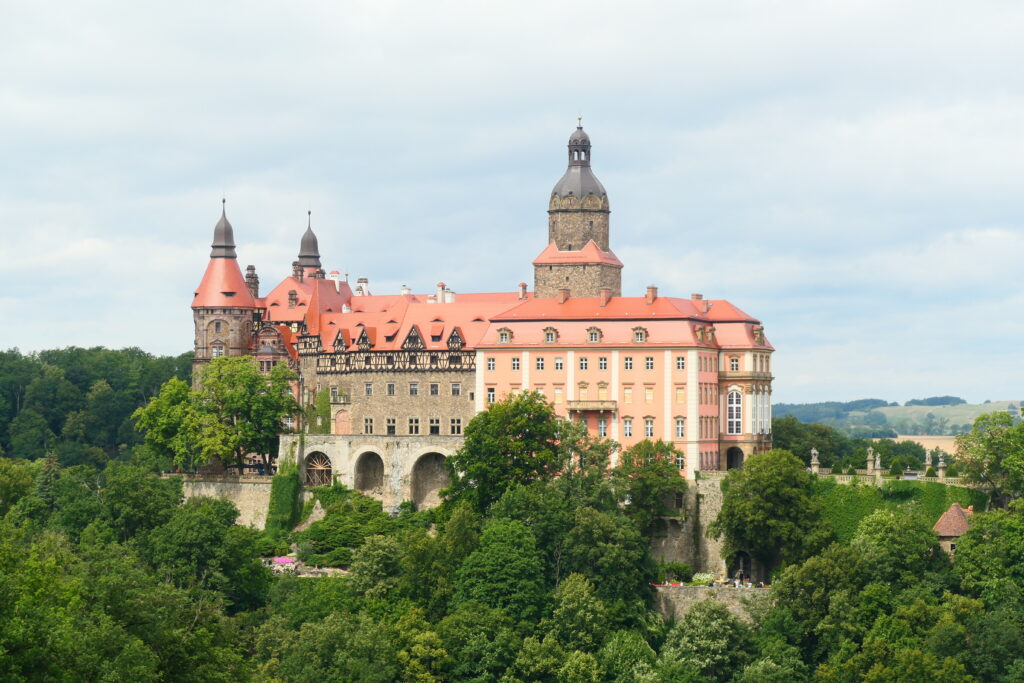
What’s it like to drive in Poland?
As with almost everywhere on the continent of Europe, they drive on the right hand side of the road in Poland.
Driving in Poland is a relatively simple affair if you’re used to driving in the UK – there are very few, if any, surprises. Poles tend to be polite drivers and do not tailgate you.
Road works in Poland
Also, when we were there, there seemed to be an inordinate amount of roadworks – in particular in the south, especially the roads from Tatra National Park to Kraków?! And they allow you to drive on roads that are only partly constructed, which is a bit bizarre, and a bit of a shock when you find yourself driving trough furrows of sand! You can read more about that in the blog!
Billboards in Poland
Also, why oh why have they allowed enormous, and I mean massively enormous advertising boards to be erected in the fields all along the motorways – it spoils the views so much. It’s like something dystopic out of end scenes in the film Brazil! … another must see film by the way, if you’ve not seen it!
Motorway service stations
Oh and also, there appear to be no motorway service stations at all! Not sure why – there are loads on the local roads and in most towns – just not on motorways! Point to note if you’re travelling long distance in Poland.
Do you require an international driving permit in Poland?
We’ve created a dedicated page to driving abroad, which answers this question, and more, which you might find helpful.
Can you use your UK driving license when driving through Poland?
We’ve created a dedicated page to driving abroad, which answers this question, and more, which you might find helpful.
Do I need a carnet de passages to drive in Poland?
We’ve created a dedicated page to driving abroad, which answers this question, and more, which you might find helpful.
What are the speed limits in Poland?
The speed limits for cars in Poland are:
- 15 mph (20 km/h) for urban driving
- 30 mph (50 km/h) outside of built up areas
- 55 mph (90 km/h) on dual carriageways
- 85 mph (140 km/h) on motorways
What currency do they use in Poland?
In Poland they use the Zloty (pronounced ‘zwoti’). The use of credit / debit cards is now widespread. Travellers cheques are accepted. There are lots of ATMs. Euros are also widely accepted, although exchange rates are often poor.
You should make yourself aware of the amount that your bank charges you for using credit and debit cards abroad. Often credit cards are cheaper for purchasing items directly, and for withdrawing cash from ATMs.
What language do they speak in Poland?
They speak Polish in Poland, although in the cities, many also Speak English or German, in particular the younger generations. We found however that it was often difficult to find people who spoke English in the more remote areas, although they did speak German.
What time zone is Poland in?
Remember, when you’re planning your next trip to take a look at what time zone it’s in.
Do I need a visa to visit Poland?
We’ve created a dedicated, more comprehensive page on visas, which you should find helpful. Check it out!
Is wild camping legal in Poland?
No, wild camping is illegal in Poland.
What plug / socket type do they use in Poland?

In Poland they use plug / socket type E.
Health issues in Poland
Is it safe to drink water in Poland?
Yes, it is safe to drink tap water in Poland. Bottled water is also readily available across the country.
What vaccinations are required for Poland?
This NHS website is kept up to date with all relevant information on vaccinations in Poland.
Phones in Poland
What is the country calling code for Poland?
The country calling code for Andorra is +48
What are the emergency phone numbers in Poland?
- The emergency number for police in Poland is: 112 / 997
- In Poland, the emergency number for ambulance is: 112 / 999
- The emergency number for fire in Poland is: 112 / 998
If you’ve got some useful info that you’d like to share, let us know!
And don’t forget to check out all the other pictures!
